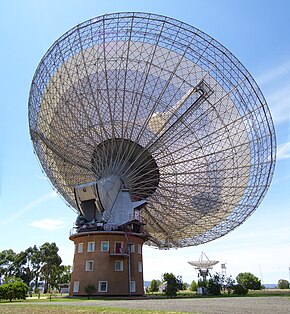 The Parkes 64m Radio Telescope | |
| Organization | |
|---|---|
| Location | Parkes, New South Wales, Australia |
| Coordinates | 32°59′52″S 148°15′47″E / 32.99778°S 148.26292°E |
| Website | www |
| Telescopes | |
| | |
| Built | 1961 |
| Official name | Parkes Observatory |
| Type | Listed place |
| Designated | 10 August 2020 |
| Reference no. | 106345 |
Parkes Observatory is a radio astronomy observatory, located 20 kilometres (12 mi) north of the town of Parkes, New South Wales, Australia. It hosts Murriyang, the 64 m CSIRO Parkes Radio Telescope also known as "The Dish",[1] along with two smaller radio telescopes. The 64 m dish was one of several radio antennae used to receive live television images of the Apollo 11 Moon landing. Its scientific contributions over the decades led the ABC to describe it as "the most successful scientific instrument ever built in Australia" after 50 years of operation.[1]
The Parkes Observatory is run by the Commonwealth Scientific and Industrial Research Organisation (CSIRO), as part of the Australia Telescope National Facility (ATNF) network of radio telescopes. It is frequently operated together with other CSIRO radio telescopes, principally the array of six 22-metre (72 ft) dishes at the Australia Telescope Compact Array near Narrabri, and a single 22-metre (72 ft) dish at Mopra (near Coonabarabran), to form a very long baseline interferometry array.
The observatory was included on the Australian National Heritage List on 10 August 2020.[2]
- ^ a b Robertson, Peter (9 February 2010). "40 Years of The Dish". ABC Science. ABC. Archived from the original on 15 July 2014. Retrieved 16 June 2014.
- ^ Furlong, Caitlin; Woodburn, Joanne (10 August 2020). "CSIRO Parkes Radio Telescope – The Dish – added to National Heritage List". ABC News. Australian Broadcasting Corporation. Retrieved 11 August 2020.
